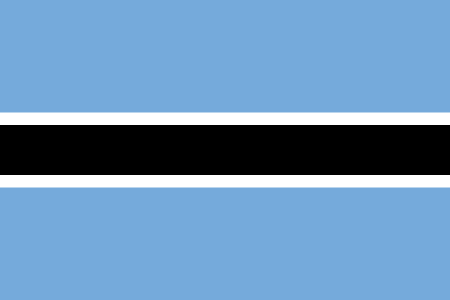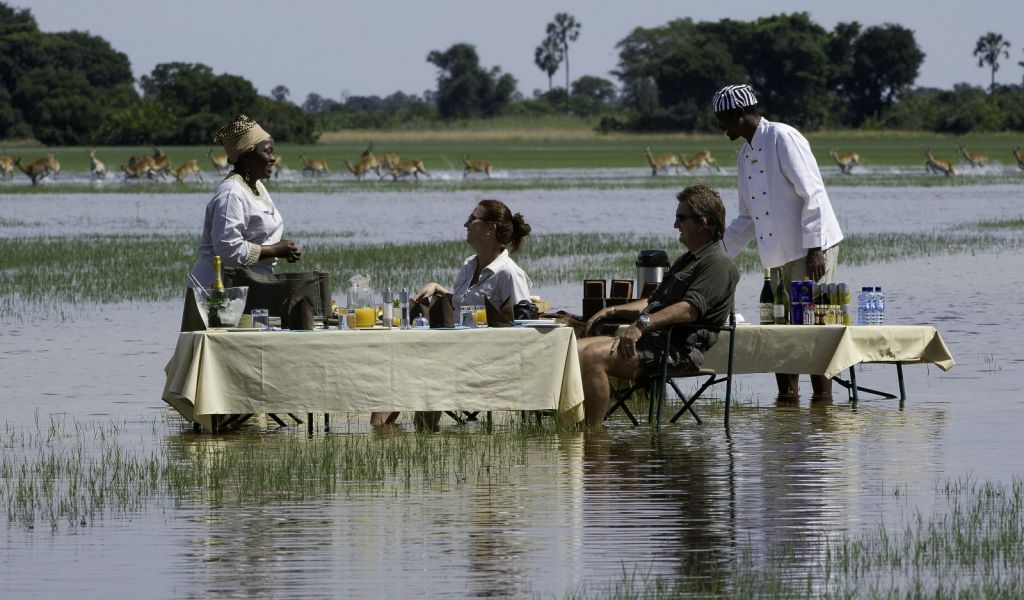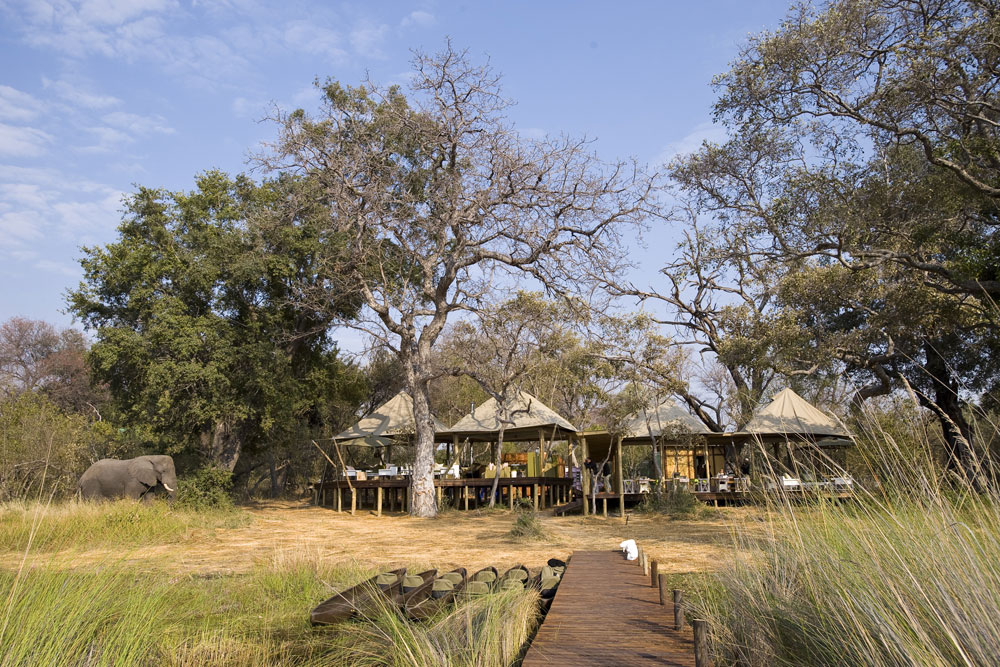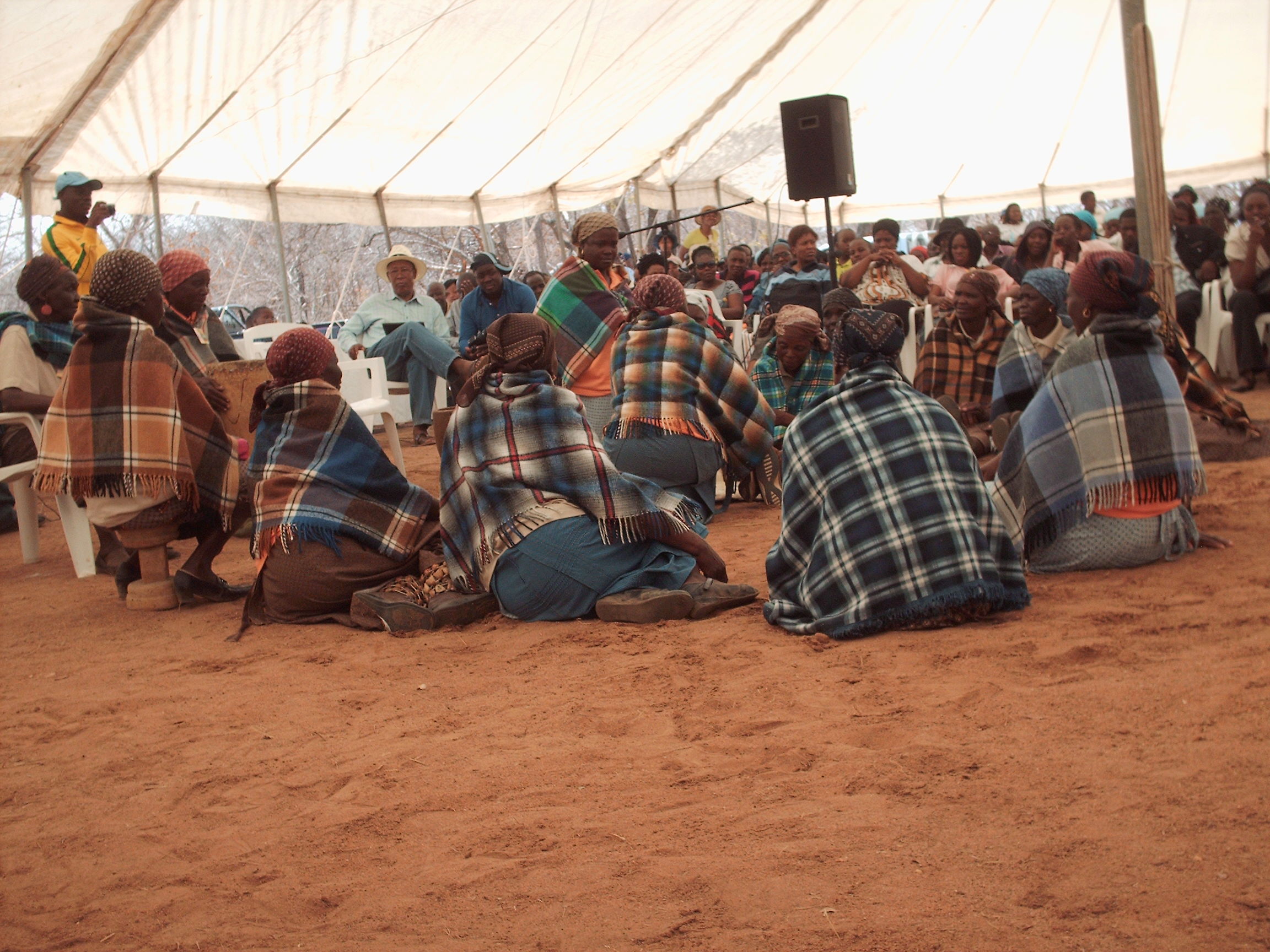










The flag is fairly simple it has blue field cut horizontality by a black strip with a white frame. Blue represents water or more specifically rain, as it is a precious resource the country relies on and sustains life. The black and white frame also had two meanings, the first being that Botswana is of diverse races that work in harmony and the second is that it represents the strips of a Zebra (the national animal).
First of all she is located in the southern area of the African continent, about the same size as France and is bordered by 4 countries. Looking at the map you would think Botswana is only bordered by Namibia, South Africa and Zimbabwe, but if you look very close at the northeastern tip where the Chobe River meets the Zambezi, you will see Zambezi in which all four countries meet. At this spot the border between Zambia via the world famous Zambezi River (historically used for centuries for navigating across the African Savannas) and Botswana is only a few meters wide. This area is right on the A-33 road that takes you to the Kazugula ferry, the only place in all Botswana that gives you direct access to Zambia
Botswana's capital and largest city is Gaborone, if you speak Setswana (native language) it is pronounced "gaH-borone" located close to the border of South Africa. The country is divided into 9 districts (North-West, Central, North-East, Ghanzi, Kweneng, Kgatleng, South-East, Southern and Kgalagadi). Wit the exception of Namibia's straight and quite distinct noticeably well-marked border with Botswana (the Caprivi Strip) most borders are Rivers.
Botswana doesn't just have a bunch of open land but also a bunch of exceptionally unique land unlike anywhere else in Africa. First of all about 70% of the country is dominated by the semi-arid Kalahari Desert in dry in the west part of the country whereas the east and the north parts are generally greener. In the far north and in the northwest district, you have one of the strangest natural phenomena, the Okavango Delta. Contrary to popular believe this is not the largest in land Delta it is surpassed by inland deltas in Mali and Sudan. However this world-renowned UNESCO Heritage Site sticks out because of the way the delta operates. Basically the Okavango meanders into geological faults, in response spread the waters out into a vast network of channels, creeks and wetlands.
Every year rain water from the highlands of Angola come down and surge into the Okavango, causing the entire flood basin to swell up to 3 times its permanent size between March and June. For the next few months, the entire area becomes this weird, shallow, swampy wetland with an abundance of wildlife that flourishes in it. In fact, one of the strangest things about this area is that it is one of the few places where you will find animals that contrary to their cousins in other areas have completely adapted to the hydrated landscape. You can see swimming cheetahs, lions and even hyenas. Finally, at the later months of the year the Okavango dries up again and about 60% of it is absorbed by plants over 30% is evaporated and the rest is either transpired into the ground aquifers of drained into Lake Ngami.
Now, granted Botswana is dealing heavily with drought and desertification in their country and is trying to combat this though legislative action. To the east, you have the even stranger Makgadikgadi and Sua pans which are the 2 large salt basins. This area used to be a lake that eventually dried up and is actually the site of Botswana's largest salt and sodium carbonate mines.Speaking of mines, since 1980's Botswana has actually been the world's largest producer of gem diamonds. Five mines have opened up since independence and the world's richest diamond mine found in Jwaneng(Debtswana Diamond mine). The diamond industry has actually played a huge role in the past as well as today in the developments of the economy and people's lives.
Botswana has just a little bit over 2 million people, the majority of whom about 80% identify as ethnically Twana. Which is where Bo-"tswana" gets its name from. Other minority groups include the Ba BaKalanga, Basarwa, Kalagari, Baherero, Batswapong and a small percentage of the population is also white. Mostly decedents from the English and European settlers during colonial days. Actually there's being a huge influx of white people moving into Botswana from neighboring Zimbabwe, as the President Robert Mugabe has instituted laws that actively discriminate and oppress the white minority. Essentially, pretty much everybody in the country speaks English but the most dominant language being Setswana be it that some ehinic gropus may have their own language eg(BaKalaka speaking kalanga ). Many of the white people speaking Afrikaanas (which is kinda like an africanized Dutch). Long story short Botswana used to be part of the British Empire under the name of Bechuanaland. The interesting thing, though is that Botswana actually has very fascinating tribal groups found along rural areas of the country. One of them being the most sought after group for studies by sociologists the San Bushman (Basarwa). The San Bushman speak a Khoisan language which is saturated with these unique click sounds.
The country operates in a democratic parliamentary republic with a president as the head of state. In fact according to Transparency International Botswana is the least courrpt government in Africa on par with countries like Portugal and South Korea. Culturally, Botswana identifies closely with other countries in the South African region. About 70% of the people identify as Cristian and regular church attenadce is high. The rest are non-religious, identify with a different religion or ascribe to folk religions.
Essentially, though Botswana used to be one of the poorest countries but today has developed a steady economy and infrastructure that has made it into the 4th largest GDP in all of Africa. On par with Mexico and Turkey. They have managed to keep both universal healthcare and education at all levels free. This is partially thanks to the mining industry, but also to the new financial sector that Botswana's heavily investing in. With strong fiscal policies and free market enterprises, Botswana was able to nab 7 billion in foreigh exchange reserves, just about 10 years ago. Today Botswanas has Africa's highest credit rating and with a well- capitalized system which allows high interst rates. Botswana seems to be doing something right.
Now when it comes to friend Botswana kind has this like this seesaw effect in which they like groups of people that typically don't like each other. First off we have Russia and the US. The US only a huge partner with multiple embassies and consulates for each side, but so far, is also the largest provider of aid and medical relief especially in the HIV and Aids amongst residens. Peace Corps proffessionals stop by and even help build facilities, as well as develop and train native Batswana to tackle the issue. Nonetheless, Russia is actually seen as a little bit more favorable to the Batswana. Russia swooped in shortly after independence in 1996 as one of the first countries to acknowledge Botswana as a nation. They hit it off really well early in the game, Russia maintains numerous trade policies and educational cooperation agreements with them and even to this day each has embassies and consulates. Russians don't need a visa to visit Botswana as a testament of their relationship.
Then you have like Israel and Pakistan. Pakistan been a favored business partner and has built ties with Botswana for years, and even has overseas embassies in Beijing and Yemen for each other. However, Israel also has cooperation agreements and invests heavily in the irrigation sector to help Botswana fight its desertification problem by suggesting models that have worked for their own country. Israel also facilitated the development of the Botswana International University of Science and Technology.
Finally you have what Botswana would consider the best friends, Namibia and South Africa. These 3 countries go way back. First, South Africa used to have some drama with Botswana, but today is really close and has signed numerous agreements in tax, agriculture, health, transport and more. A huge portion of Botswana economy is dependent on South Africa and culturally they resonate pretty close as they were both parts of the British Empire. Namibia though is really close to Botswana too but remember Namibia kind broke away and became independent from south Africa….so here we have a country that used to be part of that country being friend with this….but relationship between South Africa and Namibia are fine. Soon after Namibia's independence, Botswana was one of the first countries to shake hand and sign treaties. The only issue is that Namibia once scared Botswana because they planned on deferring the water from the Okavango River away from the Basin to help irrigate their land which would have destroyed the whole delta. Lucky the plans were diverted.